In the world of fitness apps, Strava has been one of the fastest-growing players in recent years. From its early beginnings as a tracking tool for cyclists and runners, it has evolved into a comprehensive community for athletes.
How did Strava manage to become a behemoth in the fitness app market? We will take you through the key product and growth strategies Strava employed on its way to becoming a unicorn.
Strava’s unique value proposition
Before the launch of Strava, many fitness enthusiasts were limited to tracking their workouts manually or using basic fitness apps that provided limited functionality.
What was missing from their lives was a comprehensive platform that could track and analyze all of their fitness data, while also providing a social and motivational component to keep them engaged and accountable.

Strava filled this gap by providing a comprehensive platform for tracking and analyzing fitness data, combined with a social and motivational component.
This has made it a popular app for fitness enthusiasts looking to take their training more seriously and stay connected with a community of like-minded individuals. While the app’s features are certainly impressive, Strava can meet its users’ needs with a seamless onboarding flow that truly sets it apart.
Smooth onboarding flow
Onboarding is a key piece to solving for retention – and most mobile apps have terrible retention. Improve onboarding, and you’ll significantly improve retention rates.
The app begins with a login/account creation screen offering options to sign up via email, Google, Facebook, or Apple. Once logged in, users are prompted to type in their basic personal details for a personalized experience based on their gender.
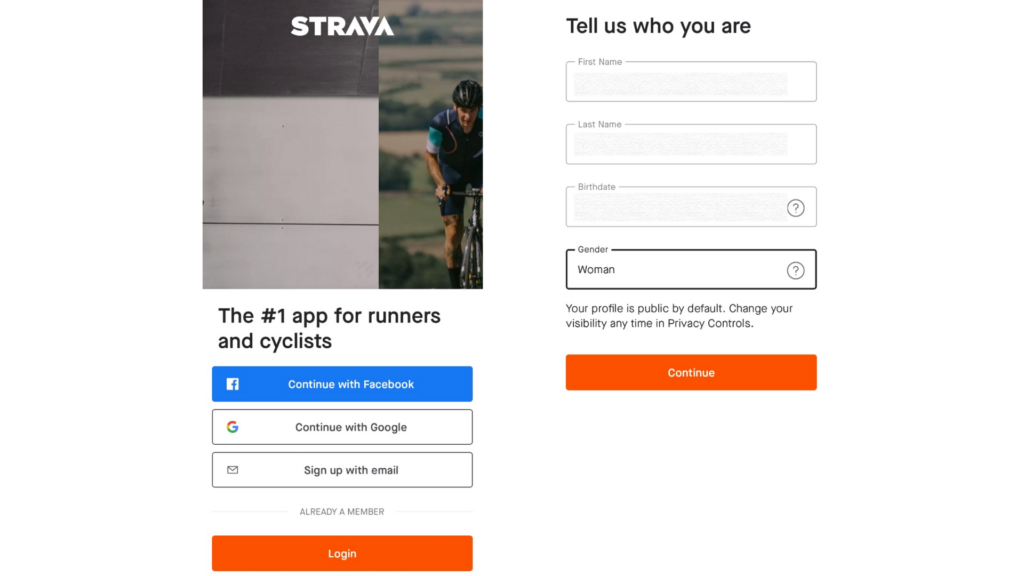

Following this, users are asked to select their preferred sport from a list of options. Later, it asks you to provide access to the location for recording various activities.
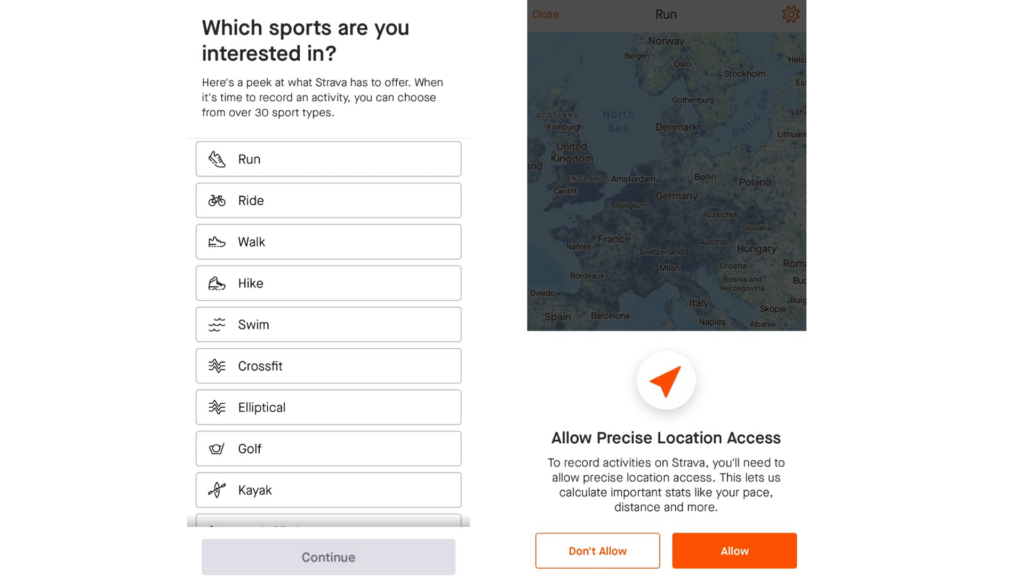

In case you’re looking for more inspiration on how the best mobile apps do onboarding, refer to the best onboarding flows from 2023.
Tapping into motivation with gamification
Strava’s gamification features have played a significant role in motivating users and driving growth. The psychology behind Strava’s focus on motivation is rooted in the idea that people are more likely to stick with a fitness routine if they feel a sense of progress and accomplishment.
Other apps looking for in-app engagement among their users can apply this principle to their platforms to create a more compelling user experience.
Here are some of the key features that have helped Strava stand out:
Strava’s segment feature
The segment feature is one of Strava’s most popular gamification features. It allows users to compete with others on specific routes, creating a virtual race between athletes.
Users can see how their performance stacks up against others who have completed the same segment, and Strava’s segment leaderboard ranks users based on their performance.
This feature has been popular among users and has even created unofficial races and challenges, where users try to beat each other’s times on popular segments.


Source: 9to5mac
Achievements and badges
Strava’s achievement and badge system is another popular gamification feature. Completing a challenge or achieving a personal best earns the user a badge, which can be shared on social media.
This feature not only motivates users to push themselves but also provides a way to show off their achievements to their friends and followers. Some users even compete to see who can earn the most badges or complete the most challenges, adding an extra layer of competition to the app.
Strava clubs and challenges
Strava’s clubs and challenges have been instrumental in building a sense of community among its users. Clubs allow users to connect with others based on shared interests, while challenges incentivize users to push themselves to their limits.
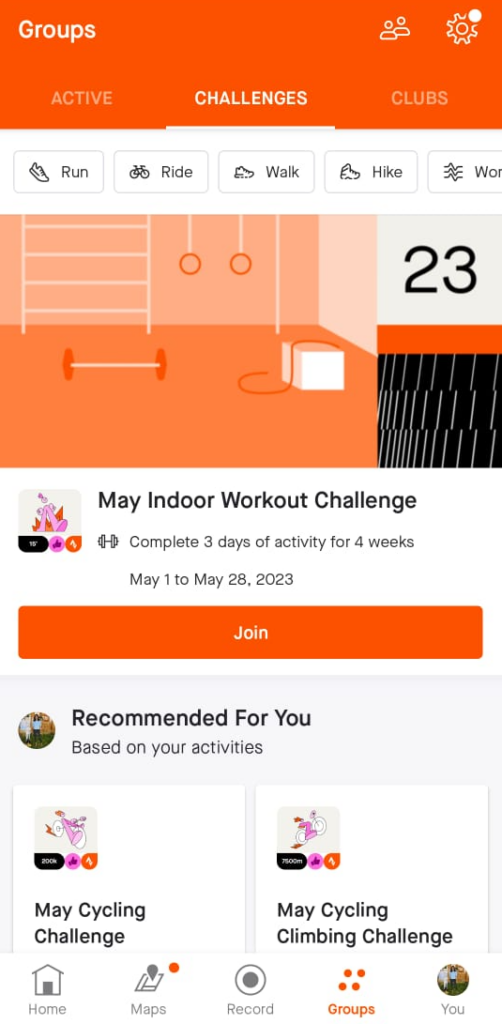

Personalized goal setting
Strava’s goal-setting feature is a personalized approach to fitness that has been instrumental in helping users achieve better results.
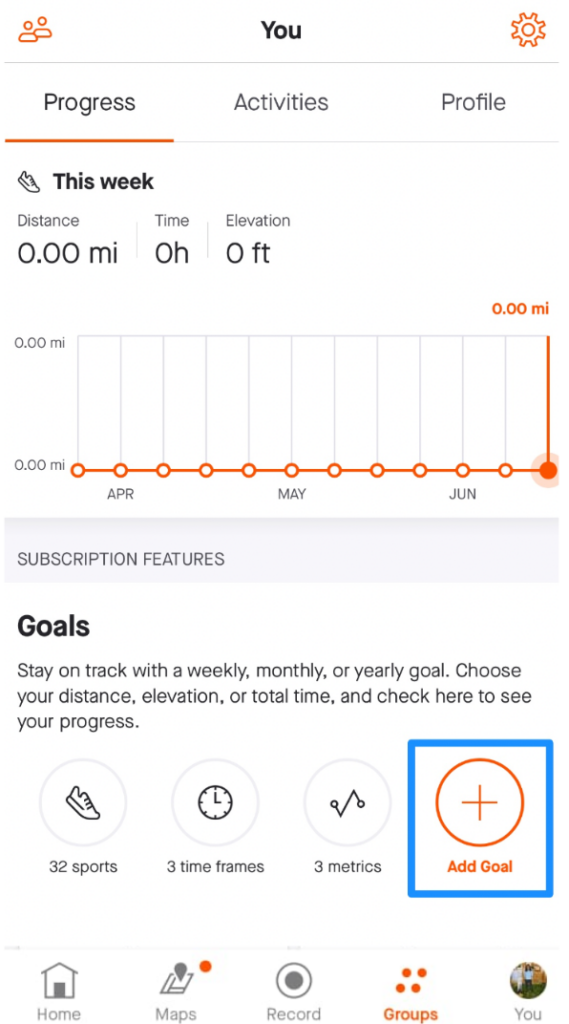

Users can set goals for distance, time, or even elevation gain, and Strava will create a plan tailored to their fitness level and schedule. The feature also provides a way for users to track their progress over time, which can be a powerful motivator to keep going.
It also provides personalized metrics with visual analytics. If you notice the below image, the app has configured two in-app nudges called tooltips highlighting the users about the heart rate and speed with the exact numbers. This helps the users get accurate values as soon as they land on this page.
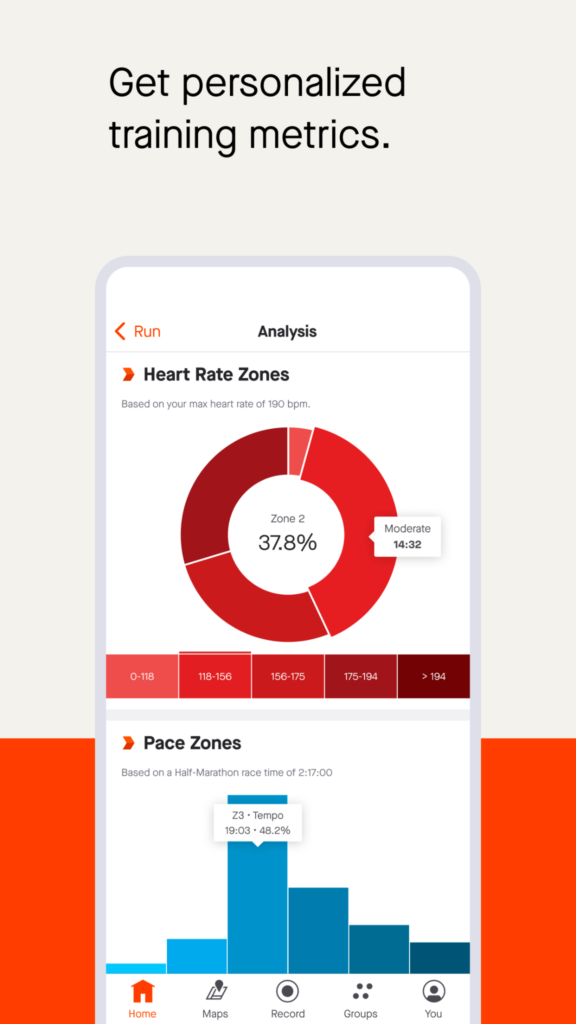

The art of building a strong community
Building a robust community of passionate users was crucial to 4. By providing a platform that encourages interaction and supports its users, it has created a loyal and passionate community that continues to grow and thrive.
Here are some strategies Strava employed to build a thriving community:
Encouraging user engagement and interaction
It offers a range of social features, such as leaderboards and challenges, that incentivize users to engage with others. Strava also allows users to share their workouts on other social media platforms such as Facebook and Instagram.
Furthermore, Strava has a feature where users can give kudos to other users’ activities. This simple feature has created a culture of positivity and support within the community, where users can acknowledge and celebrate each other’s accomplishments.
Leveraging social media
Strava has been able to leverage social media platforms to drive growth. By allowing users to share their workouts on social media, Strava has enabled users to become brand ambassadors, which has helped it reach a wider audience. Strava also regularly shares user-generated content on its social media channels, which helps to reinforce its brand values and highlight the community experience it offers.
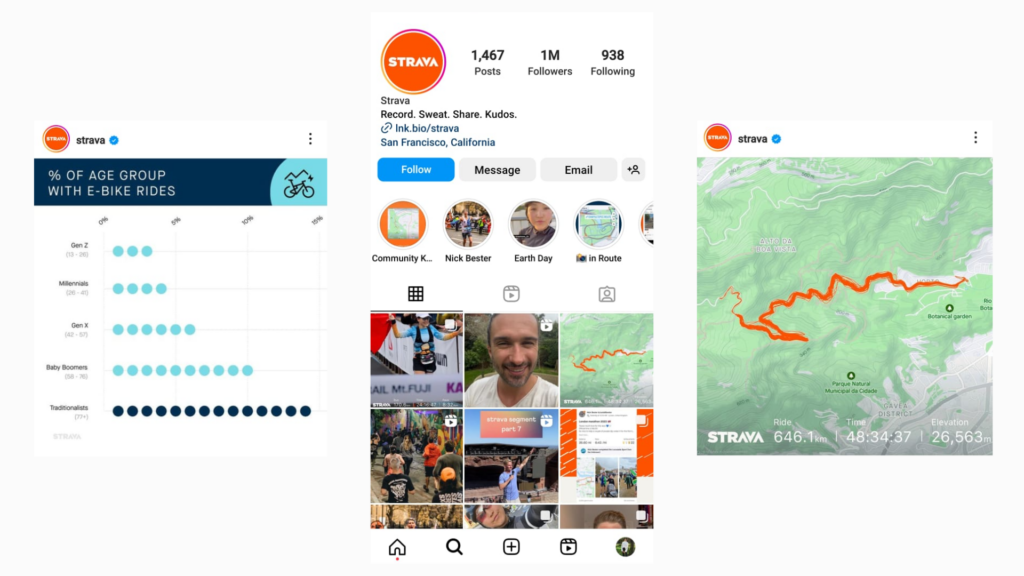

In addition, Strava has partnered with social media influencers, fitness bloggers, and professional athletes to help spread the word about its platform. This has helped to increase brand awareness and attract new users to the community.
Strategic partnerships and integrations
Strava’s growth has been largely attributed to its strategic partnerships and integrations. These collaborations have enabled the platform to expand its reach and offer users more comprehensive features.
Here are some of the key partnerships that have contributed to Strava’s growth:
Collaborations with brands
Strava has formed collaborations with various fitness brands to offer exclusive challenges and promotions to its users. These partnerships have helped to incentivize users to engage more with the app and have increased Strava’s brand visibility among fitness enthusiasts.
One such partnership is with Lululemon, a popular athletic apparel brand. Lululemon has partnered with Strava to create virtual run clubs, which allow users to connect with other runners in their area.
Also, from April 2023, Strava has teamed up with Spotify to allow users to listen to songs, podcasts, and audiobooks while they monitor their workouts. This way, Strava users will no longer need to switch between apps and allow them to tap easily into their workout tracks.
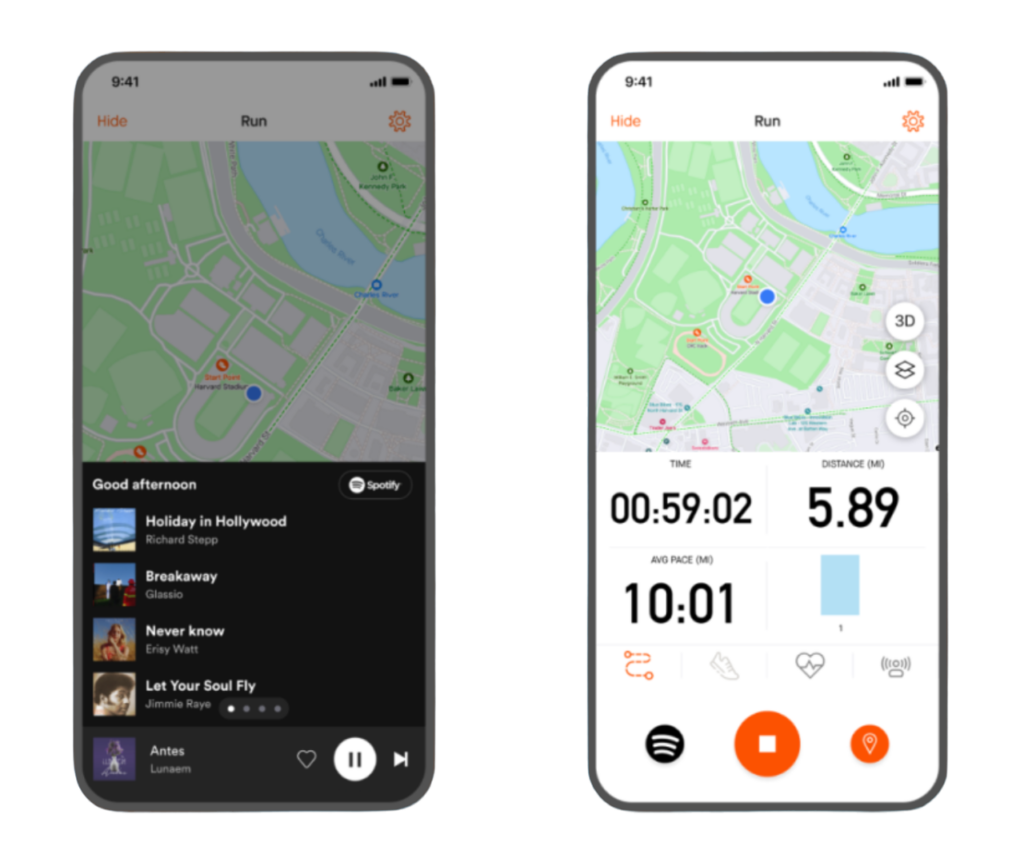

Source: 9to5mac
Integration with wearable technology
Strava’s integration with wearable technology has made it easier for users to track their workouts seamlessly. The platform has integrated with popular wearable devices, such as Garmin watches, to offer users a more comprehensive workout tracking experience.
Garmin and Strava’s integration has been particularly successful, with users able to track their runs, rides, and swims with ease. This integration has enabled Strava to reach new audiences and helped to reinforce its position as a comprehensive tracking app for athletes.
Strava’s API for third-party developers
Strava’s API allows third-party developers to integrate with its platform, which has enabled more extensive data analysis and integrations. This has allowed Strava to expand the range of products it offers and facilitate growth in new areas.
One example of a third-party integration is with the app MyFitnessPal. MyFitnessPal users can link their accounts with Strava to automatically track their calorie burn during workouts. This integration has helped to streamline the tracking process for users and has provided Strava with an opportunity to reach a new audience.
Excited to see what’s next for Strava
Overall, Strava’s viral growth can be attributed to its ability to provide a sense of community, gamification features, and data analysis capabilities to athletes around the world. As the app continues to evolve and adapt to the changing needs of its users, it is likely to remain a dominant player in the fitness app market.


After hitting a $1.5B Valuation and 100M+ Users, Strava strives to constantly iterate and achieve spectacular growth in 2023 too.
When viewing Strava’s mindset down the line, there are lots of acquisitions and partnerships on the line like the recent Fatmap and Spotify respectively. Additionally, their future aligns with finding more opportunities with artificial intelligence to drive revenue growth.
If you would like to send s the news about your startup contact us.


Ananya Vairavarajan
Ananya is a B2B SaaS growth enthusiast with a focus on PLG. She loves how technology drives company growth and solves business challenges. When not on my computer, I enjoy yoga and indulging in the guilty pleasures of food exploration.

















































